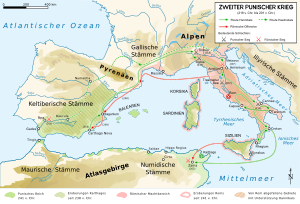Siege of Saguntum
Coordinates: 39 ° 41 ′ 0 ″ N , 0 ° 17 ′ 0 ″ W.
| date | 218 BC Chr. |
|---|---|
| place | Saguntum in Spain |
| output | Carthaginian victory |
| Parties to the conflict | |
|---|---|
| Commander | |
|
unknown |
|
| Troop strength | |
| inferior | consider |
| losses | |
|
the population was killed or enslaved |
relatively low |
Saguntum - Lilybaeum II - Rhone - Ticinus - Trebia - Cissa - Lake Trasimeno - Ager Falernus - Geronium - Cannae - Nola I - Nola II - Ibera - Cornus - Nola III - Beneventum I - Syracuse - Tarentum I - Capua I - Beneventum II - Silarus - Herdonia I - Upper Baetis - Capua II - Herdonia II - Numistro - Asculum - Tarentum II - New Carthage - Baecula - Grumentum - Metaurus - Ilipa - Crotona - Large fields - Cirta - Zama
The siege of Saguntum was an eight month battle over the city of Sagunt between the Iberians, allied with the Romans , and Carthage in 218 BC. Chr. Hannibal was able to take the city after a long siege. The siege is considered to be the prelude to the Second Punic War .
prehistory
Hannibal had come with his Carthaginian army from North Africa across the Mediterranean to the Iberian Peninsula. There he was joined by numerous mercenaries from Celtiberian tribes who were at war with Rome. Because of the easier walking routes he followed the coast to get to Italy, supported by many enemies of Rome. But there were also opponents of Hannibal in Spain: the Iberians, allied with the Romans, had started a revolt in Spain against the Carthaginian invaders. Again and again they plunged the great marching army into skirmishes and repeatedly hit the Carthaginians hard with quick cavalry attacks. In order to crush the resistance of the rebellious locals, Hannibal set out to conquer their important fortress city, Saguntum. A protracted siege followed.
The siege
Hannibal did not succeed in storming the city fortress because he had no suitable siege equipment. Since Saguntum was close to the coast and Hannibal had hardly any ships available, the city's residents repeatedly managed to bring food by sea. The residents of Saguntum sent messengers to Rome with the request for a relief army, but this did not materialize. The siege dragged on for months, while the townspeople made repeated failures. It was only after eight months that the defense lawyers were starved to the point that they surrendered to Hannibal. 218 BC The Carthaginians entered the city.
consequences
Hannibal had the Iberian resistance punished in bloody fashion: most of the men were killed, and women and children were sold into slavery. After a break of a few weeks in Saguntum, the Carthaginian army moved on.
The siege of Saguntum is evidence of the support of Rome by other peoples in the Punic Wars, and an indication that Rome and Carthage were not the only parties to the conflict in the Second Punic War.
literature
- Polybios : History of Rome. Book III.15-17; see. III.6–8 and 29 f.
- Titus Livius : The fight with Hannibal. Penguin Verlag, 1972, p. 28 ff.
